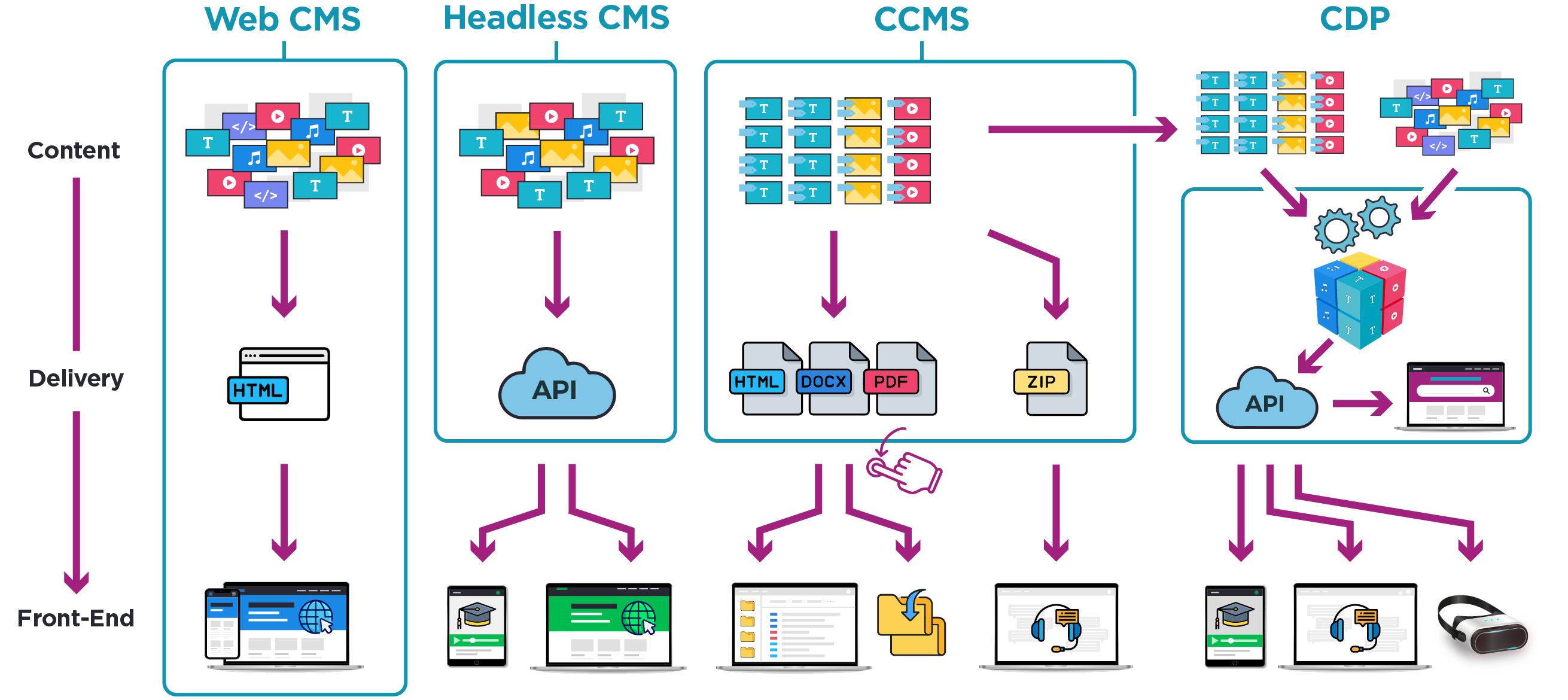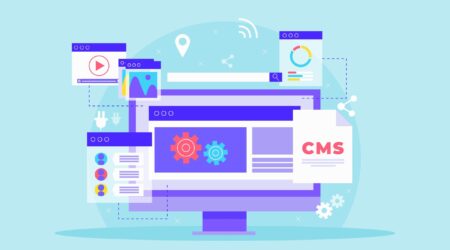
CMS, headless CMS, CCMS, and CDP: Understand What They Are and What You Need
Everything you've ever wanted to know about CMS, headless CMS, CCMS, and CDP. Discover what solution works for your own business case.

CMS, headless CMS, CCMS, and CDP. If you are a content professional, technical writer or marketer, these are terms you hear on a daily basis.
Do you actually know the difference between the traditional Web CMS that your company probably uses for its corporate website and a new-generation Content Delivery Platform (CDP)?
Take 5 minutes to understand each solution’s specifics and see what works for your own business case.
CMS
A CMS, short for Content Management System, is a software application that creates, stores, and manages digital content. The term CMS is often used by extension for Web Content Management System (WCMS), a type of CMS dedicated to building and editing websites.
WCMSes enable users to create and modify pages as well as organize these pages according to the structure of the website. One of the great benefits of WCMSes is their general ability to extensively customize and brand webpages.
On the other hand, one of their limitations is that WCMS-created content is unstructured, produced in and for a given webpage, and mixed with the format and page code. The webpage content is impossible to reuse on other pages or channels beyond the tedious, error-prone copy-paste operation.
WordPress, Drupal, Wix, Squarespace are some of the most popular Web CMSes on the market.
Headless CMS
A headless CMS is a back-end-only content management system that acts primarily as a content repository. With a headless CMS, the content is decoupled from the presentation layer and made accessible via an API to any channel or device.
Headless CMSes enable multi-channel publishing, that is, publishing the same content, created once in the CMS, to multiple endpoints.
Most headless CMSes, like traditional CMSes, only allow the creation and storage of unstructured content, i.e. monolithic content used as a whole – think of a document without a template.
This works well for publishing the same troubleshooting guide to either a product website, a knowledge center and/or a community portal. But it doesn’t work for repurposing the same guide for channels that require a higher level of content granularity such as chatbots and AR/VR devices, for step-by-step resolution. In addition, you wouldn’t be able to mix that content again to create different, contextualized or personalized versions of a webpage or a document.
CCMS
A Component Content Management System or CCMS is a CMS that manages content at a component level rather than at the document level. Components are either words, paragraphs, or series of paragraphs, images, videos, and more. They are tagged with metadata that provides additional information (e.g. the author, audience, product version,…) about the content itself and facilitates content management and searches.
In CCMSes, the structure of the content is standardized so that the system can assemble and reuse the different components for different publications. As such, CCMSes enable collaborative and topic-based authoring, as well as a higher content creation productivity.
CCMSes offer the ability to publish documents and pages, mostly in PDF, MS Word and HTML formats. Some CCMSes also feed helpdesk tools and other applications through the transfer of files formatted for each endpoint. Very few offer APIs.
It’s worth noting that CCMSes only handle and publish the content that was authored within the CCMS itself and exclude all other content (PDF datasheets produced by product managers or marketing documents created with MS Word).
Ixiasoft, RWS (Tridion), Paligo, Bluestream (XDocs DITA CCMS), Intuillion (DITAToo), and Componize offer some of the most popular CCMSes on the market.
CDP
A Content Delivery Platform is a software solution that collects all types of content sources and formats, unifies them into a central knowledge hub, and makes content available to multiple digital endpoints via APIs.
CDPs are agnostic of the authoring tool and offer different ranges of standard and custom connectors, from the most popular to very specific in-house writing systems. As such, CDPs extend the collaborative process of content creation across the organization by integrating a wider range of content types, such as Microsoft Word documents or Markdown files provided by stakeholders external to the documentation team.
Advanced CDPs handle both structured and unstructured content, processing the latter to align metadata and provide the same granularity as natively structured content.
By doing so, CDPs create unified user experiences across all content sources and for all digital endpoints, including modern devices such AR/VR. Also, note that most CDPs offer a front-end portal by default with variable customization capabilities.
Beyond multi-source/omnichannel content publishing, CDPs enable Content-as-a-Service: they allow companies to deliver contextualized and personalized content to users on the device and at the touchpoint of their choice.
Fluid Topics is the leading Content Delivery Platform for technical documentation and provides a large range of connectors for a variety of CCMSes, authoring tools (MadCap Flare, Adobe FrameMaker,…), common formats and languages (OpenAPI, Markdown,…) and more specific content types. The solution also offers a full-fledged portal out of the box and a rich set of secured APIs.

To help you choose what solution is right for your business case, here is a recap table that highlights the main differences between these 4 types of solutions.
Still have questions on what solution will better meet your needs? Want to see how a CDP works? Get in touch with us!
Get a free demo of Fluid Topics with a product expert



